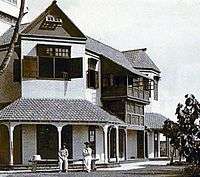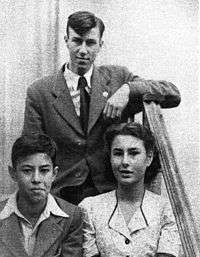Clunies-Ross family


The Clunies-Ross family were the original settlers of the Cocos (Keeling) Islands, a small archipelago in the Indian Ocean. From 1827 to 1978, the family ruled the previously uninhabited islands as a private fiefdom, initially as terra nullius and then later under British (1857–1955) and Australian (1955–1978) sovereignty. The head of the family was usually recognised as the resident magistrate, and was sometimes styled as the "King of the Cocos Islands" – a title given by the press.
History
John Clunies-Ross
John Clunies-Ross was a merchant originating from the Shetland Islands. In 1813 he was at Timor as Third Mate on board the whaler Baroness Longueville when he received the opportunity to become captain of the brig Olivia, which opportunity he took.[1]
Reportedly he first cruised the waters of the then uninhabited Cocos (Keeling) Islands in 1825. After surveying them he moved his family to live on one of the islands in 1827.[2]:188 [3][4] Only Joshua Slocum used different dates, when he wrote that "John Clunis-Ross, who in 1814 touched [the island] in the ship Borneo on a voyage to India", nailed up a Union Jack with plans to settle in the future and "[..] returned 2 years later with his wife and family".[5] He planted "hundreds of coconut palms and brought in Malay workers to harvest the nuts", building a business by selling copra.[6] In the beginning, Javanese convicts were used as laborers and "crime of all kinds was rife", before "getting rid of the criminal class and obtaining a better type of Malay coolie."[2]:188 According to a 1903 article in The Timaru Herald Ross "...[ran] his little colony on model lines and succeeded beyond expectation" and Charles Darwin mentioned after his 1836 visit with the H.M.S Beagle that he "found the natives in a state of freedom".[3] However the article left out the sentence that immediately followed :"but in most other points they are considered as slaves".[7][4] Ross traded with Dutch vessels going to Dutch ports on Java and Sumatra and became a naturalised Dutch subject;[3] He had approached both the British and the Dutch government for annexation but neither had responded.[2]:188
John George Clunies-Ross
In 1851, his son John George Clunies-Ross (Ross II) took over, and in 1857 British Captain Stephen Grenville Fremantle visited aboard the HMS Juno who "took possession of the islands in the name of the Britannic Majesty's Government." Fremantle appointed John George as superintendent of the islands and left after a 3-month vacation. The connection to Britain changed nothing in Ross' autonomous administration and it was not until fifteen years later another British ship arrived for a complete survey of the island.[3] Apparently Fremantle annexed the islands by mistake, thinking he had arrived on the Coco Islands of the Andaman Islands.[2]:188
George Clunies-Ross
In 1871, George Clunies-Ross (Ross III) became superintendent after his father had died.[3] It was during his administration, in 1885, that the first annual inspection by a representative of the Straits Settlements Government occurred.[2]:189 In 1886 Queen Victoria granted the islands in perpetuity to the Clunies-Ross family.[6] Representatives of the Government of the Straits Settlements were sent to the island each year and reports reflected that "members of the Clunies-Ross family are to-day in every sense of the word proprietors of the islands, for Mr George Clunies-Ross makes his own laws and interprets them, polices his little domain, provides his own coinage [...] controls the entire trade and acts as "the universal provider" to satisfy the wants of the community".[3] According to Chambers' Journal, there had not been any metallic coins since 1837.[2]:188
John Cecil Clunies-Ross
The title to the islands was claimed by the Ross family until 1978, when John Cecil Clunies-Ross (Ross V) sold the islands to the Commonwealth of Australia for £2.5m ($4.75m).[6] The Commonwealth had already been administering the islands since 1955 and threatened expropriation. As of 2007 John Cecil Clunies-Ross lived in Perth, Western Australia.[6]
John George Clunies-Ross
As of 2007 John George Clunies-Ross born 1957 lived on West Island.[6]
List of Kings
The dates in the table are from the abridged family tree published by the Australian Broadcasting Corporation in their 2004 series Dynasties.[8]
| King | Regnal name | Born-Died | From | Until |
|---|---|---|---|---|
| John Clunies-Ross | Ross I | 1786–1854 | 27 February 1827 | 26 May 1854 |
| John George Clunies-Ross | Ross II | 1823–1871 | 26 May 1854 | 8 June 1871 |
| George Clunies-Ross | Ross III | 1842–1910 | 8 June 1871 | 7 July 1910 |
| Sydney Clunies-Ross | Ross IV | 1868–1944 | 7 July 1910 | 14 August 1944 |
| John Cecil Clunies-Ross | Ross V | 1928– | 14 August 1944 | 1 September 1978[9] |
See also
- List of administrative heads of Cocos (Keeling) Islands
- Ian Clunies Ross, prominent Australian scientist and administrator and relative of the Clunies-Ross family
References
- ↑ Farram, Stephen (2007) "Jacobus Arnoldus Haazart and the British interregnum in Netherlands Timor, 1812-1816". Unpublished work accessed 8 November 2016.
- 1 2 3 4 5 6 "The Cocos Islands". The Chambers's Journal. Edinburgh. 76: 187–190. 1899. Retrieved 12 April 2016.
- 1 2 3 4 5 6 Long, Edward E. (3 October 1903). "King of the Cocos Island". Timaru Herald, Volume LXXIX, Page 2 (Issue 12187). Via Government of New Zealand. Retrieved 15 February 2015.
- 1 2 "Dynasties series: Clunies-Ross Timeline, episode 2". www.abc.net.au. ABC Australia. 16 November 2004. Retrieved 12 April 2016.
- ↑ Joshua Slocum, (1901} "Sailing Alone Around the World", New York Century Co, Pan American edition, p. 212
- 1 2 3 4 5 Nick Squires The man who lost a 'coral kingdom' BBC News, 7 June 2007
- ↑ Keynes, Richard (2001), Charles Darwin's Beagle Diary, Cambridge University Press, pp. 413–418, retrieved 12 April 2016
- ↑ "Dynasties series: Clunies-Ross family tree, episode 2". www.abc.net.au. ABC Australia. 16 November 2004. Retrieved 12 April 2016.
- ↑ "Cocos Islands (State)". iinet.au. 10 December 2012. Retrieved 11 April 2015.
Further reading
- Clunies-Ross, John Cecil; Souter, Gavin The Clunies-Ross Cocos Chronicle, Self, Perth 2009, ISBN 9780980586718
- Ross, J. C. (May 1835). "The Cocos' Isles. Letter to the Editor, New Selna, Cocos' Isles, July 8th, 1834". Blackwoods Edinburgh Magazine. The Metropolitan, part 1. Peck and Newton. pp. 219–221.
External links
- Cocos Island page Genealogical Gleanings